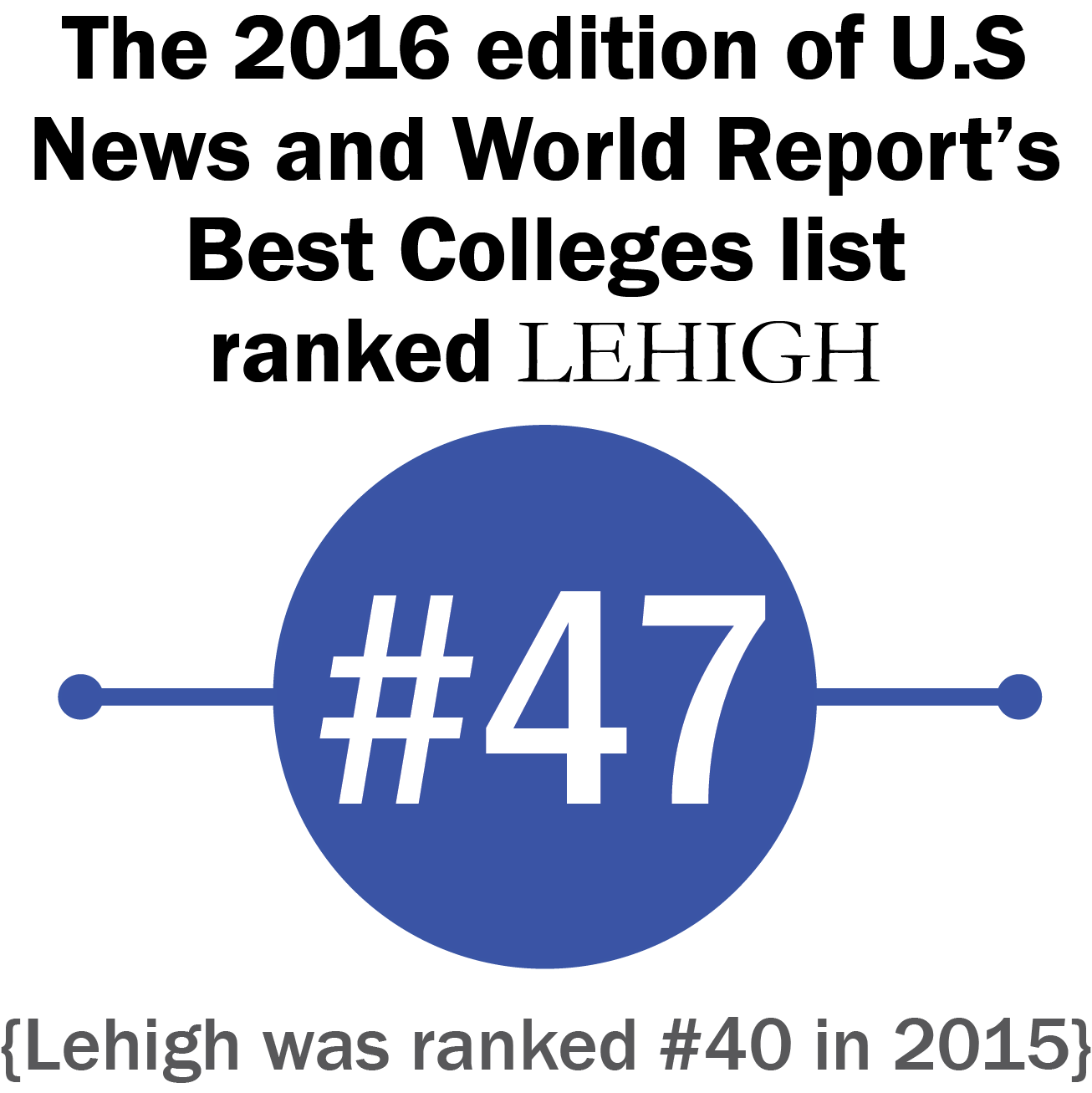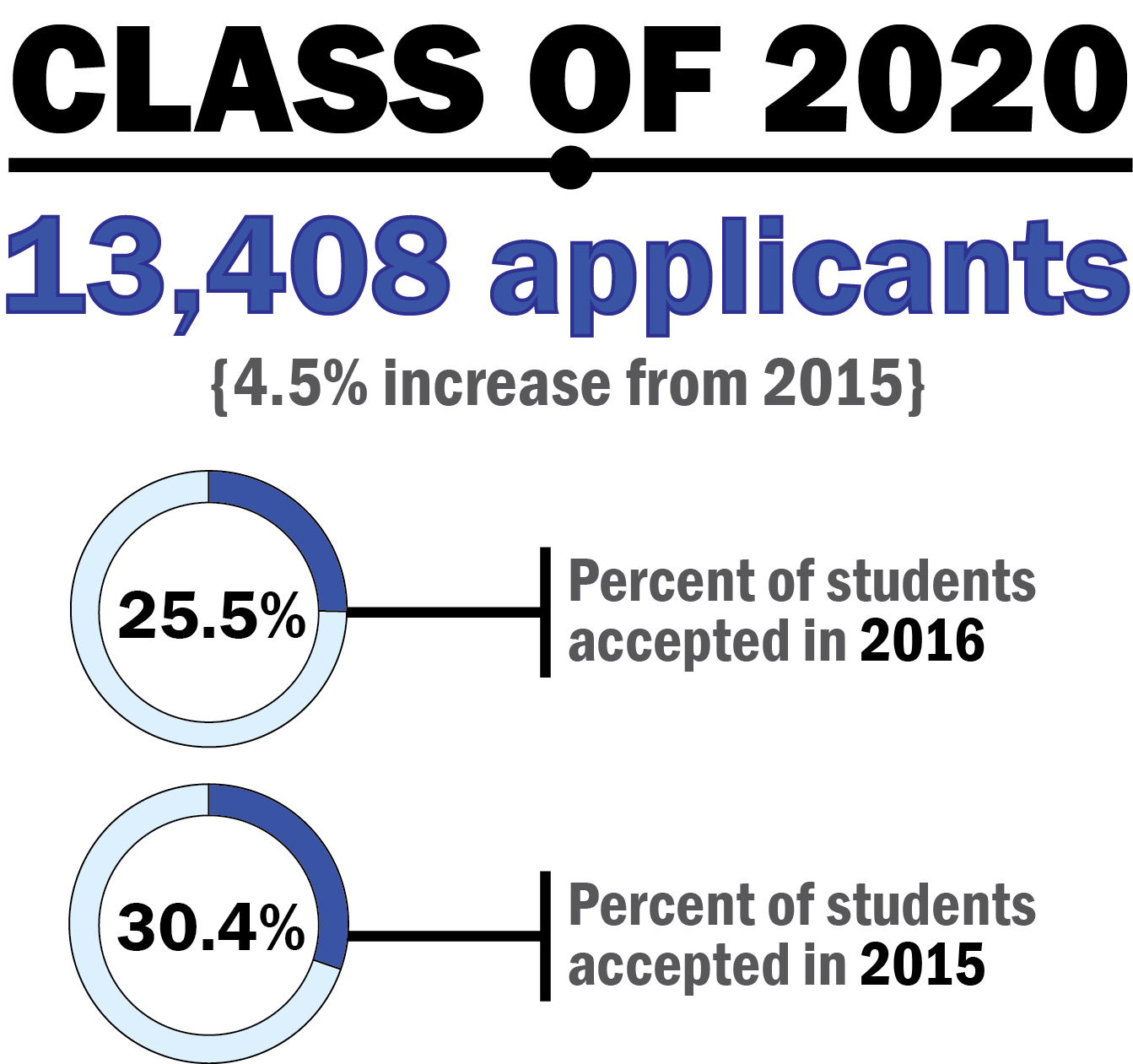April is not an easy month for Lehigh’s Office of Admissions. Beginning in late March, the halls of the Alumni Memorial building are flooded with high school students clutching plastic bags with “Lehigh” stamped on the front, a clear giveaway that its owner is a visitor to campus.
Between hosting Lehigh Life Day events for accepted students, answering the flood of emails from those who were placed on the wait list and assisting high school juniors who are just beginning their college search, the director of Admissions Bruce Bunnick has a lot on his mind.

(Samantha Tomaszewski/B&W Staff)
Something that does not keep Bunnick awake at night, however, is the university’s ranking.
In the 2016 edition of U.S. News and World Report’s Best Colleges list, Lehigh was ranked No. 47 in the National Universities category, falling seven spots from 2015. Despite this drop in rankings, Bunnick said it has had little effect on Lehigh’s admissions for this past year.
“I really take the whole notion of rankings with a grain of salt,” Bunnick said. “I don’t know that we need to be ranked to prove the work the students are doing, or the impact they leave behind on the world.”
Over the last year, the public pool for the class of 2020 increased by 4.5 percent, with Lehigh seeing its highest number of applications to date. With 13,408 students applying, the acceptance rate also fell below the previous year. Only 25.5 percent of students were accepted this year, compared to 30.4 in 2015. Given these increases, Bunnick said he is not fazed by the change in rankings.
“It’s simply one small factor among many,” Bunnick said. “What the university offers prospective students appeals to them more than just them opening a ranking list and seeing where a school falls.”
Neil Martin, a high school junior, echoed these ideas following a tour of the university Tuesday afternoon. Although he said he checked U.S. News and World Report’s rankings, he said the rankings did not hold much sway over his decision.
“People in my grade check them when you’re first starting out, but the seniors at my high school just use them almost as bragging rights,” Martin said. “I don’t know why you’d base your college decision off of a list someone else made up.”

(Samantha Tomaszewski/B&W Staff)
Martin said he was not concerned with Lehigh’s change in rankings, and he questioned what could have changed in a year to cause the drop. Similarly, Bunnick referenced a lack of transparency on U.S. News and World Report’s part, as the metrics used for the rankings are not always made clear to the general applicant.
According to U.S. News’ website, the largest metric taken into consideration is a university’s undergraduate academic reputation, totaling 22.5 percent of its rank. Graduation and retention rates equal 22.5 percent, faculty resources for the previous year amount to 20 percent, student selectivity for the previous class make up 12.5 percent, financial resources constitute 10 percent and the graduation rate performance is 7.5 percent.
The final metric for a university’s rank is alumni giving, which contributes 5 percent. Chad Davis, the senior director for the Lehigh Fund, said this is an area that has not seen tremendous change over the last few years. Instead, Davis said this metric has remained consistent, hovering between 22 and 24 percent of alumni. Davis said the number of donors has increased over the past few years, going from 11,300 donors in 2009 to 12,812 in 2015.
Both Davis and Bunnick said Lehigh did see a drop in its ranking with the U.S. News system, but this was not the case for other lists, where the university’s spot has remained the same or improved. Referencing the Princeton Review and Forbes in particular, Davis said these rankings, which include metrics like pay scale and median salary of alumni, can give a more realistic impression of the university.
“These show Lehigh for its tremendous opportunity of outputs, or what actually happens when you graduate, as opposed to the U.S. News rankings, which show inputs,” Davis said.
With decision day for accepted students approaching May 1, Memorial Walkway is filled each morning with high school students and their families touring campus. Lehigh may have taken a fall in its U.S. News ranking, but based on the wide berth students have to give the tours on their way to class, interest in the university has not fallen with it.





Comment policy
Comments posted to The Brown and White website are reviewed by a moderator before being approved. Incendiary speech or harassing language, including comments targeted at individuals, may be deemed unacceptable and not published. Spam and other soliciting will also be declined.
The Brown and White also reserves the right to not publish entirely anonymous comments.
2 Comments
A classic way for universities to appear more selective, thus move up in the US News rankings, is by lowering acceptace rate.
Given the circumstances, Lehigh has to lower the acceptance rate, rankings or no rankings.
There are two factors that typically “signal” a drop in acceptance rates: (1) rising applicant volume, and (2) overenrollment. Both of those signals have been flashing at Lehigh.
First, the number of applications has risen over the past three years, from 11,512 to 12,843 to 13,408 this year (the highest ever). Mathematically, you have to expect that acceptance rates will fall as the number of applications rises.
Second, Lehigh has been experiencing overenrollment issues. Lehigh’s target is about 1,200 students per class. For the Class of 2018, they accepted too many students, and wound up with a class of about 1,320 (the largest ever). So it was pretty clear that the acceptance rate, which was 34% for that class, was going to drop. For the Class of 2019, the acceptance rate fell to only 30%, which resulted in a smaller class of about 1,260. But that was still too high. So it was easy to predict that the acceptance rate was going to fall again.
Put both of these factors together — rising applicant volume plus overenrollment problems — and you get a low acceptance rate of 25.5%. It’s true that this may improve Lehigh’s standings in the US News rankings, but Lehigh would be forced to lower the acceptance rate even if the rankings did not exist.